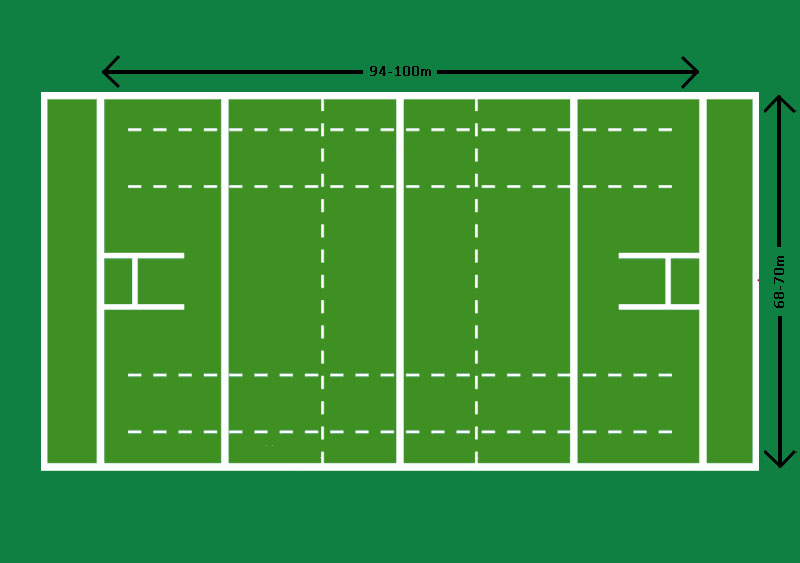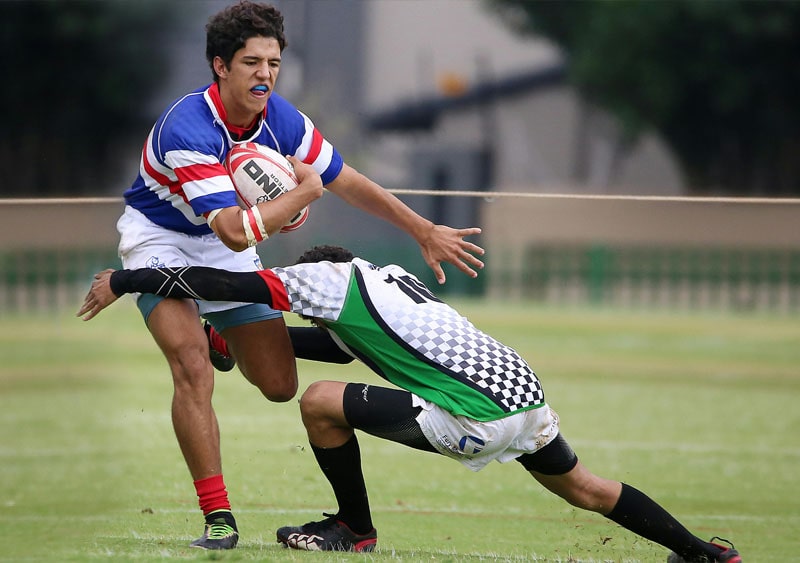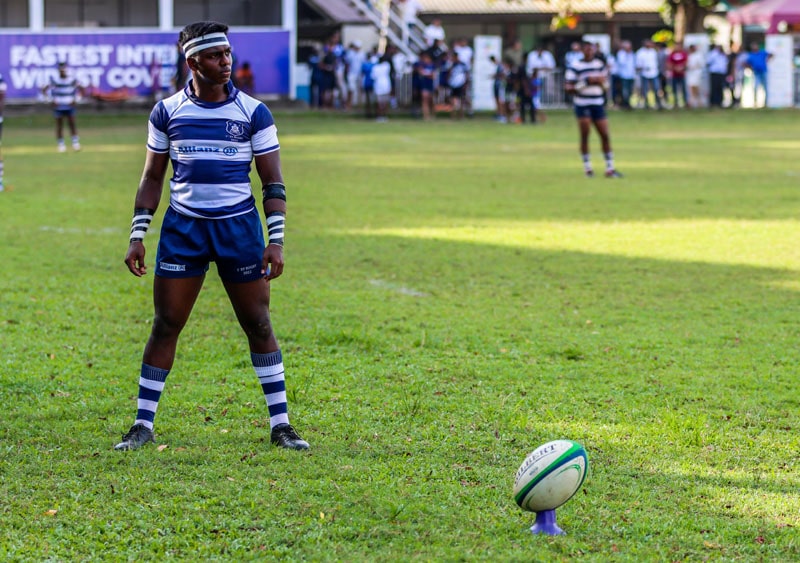Rugby is a dynamic and physically demanding sport, played by millions worldwide. Rugby began in England in the early 19th century. It has since grown in popularity. The sport is celebrated for its fast-paced action, strategic play, and team coordination. This guide will teach you the basic rugby rules. It will help you better understand and enjoy the game.
Basic Equipment for Rugby
To play rugby, the following equipment is essential:
- Rugby Ball: An oval-shaped ball, larger than a standard football. It is designed for easier handling during passing and kicking.
- Field: Rugby is played on a rectangular field, with a length of 94-100 meters and a width of 68-70 meters. The field includes key markings such as the halfway line, 22-meter lines, and try lines.
- Goalposts: The posts, shaped like an “H,” are at each end of the field. Points are scored when the ball is kicked between them.
- Protective Gear: Rugby is a contact sport. Players must wear minimal protective gear. Typical gear includes mouthguards, soft headgear (scrum caps), and padded clothing.
Objective of the Game
The primary objective of rugby is to score more points than the opposing team by the end of the match. The team can earn points in several ways. They can ground the ball in the opponent’s in-goal area (called a try). You can also kick the ball through the goalposts or score with penalty kicks.
Teams work together to advance the ball up the field, mainly by running and passing. The opposing team tries to stop them with tackles and a strong defense. The game emphasizes teamwork, strategy, and physical endurance.
The Rugby Field
The rugby field has several key areas that play a crucial role during the game:
- Dimensions: The field is 94-100 meters long and 68-70 meters wide. It has two in-goal areas at either end, typically 10–22 meters deep.
- Halfway Line: This line marks the center of the field. The game begins with a kickoff and restarts after each score.
- 22-Meter Line: It is 22 meters from each goal line. It marks a key area for both defensive and offensive play.
- Try Line: This line players must cross to score a try by grounding the ball in the in-goal area.
- Goalposts: They are on the try line. The posts are for conversions, penalty kicks, and drop goals.

Team Structure and Positions
A rugby team has 15 players, each in a specific position. The players fall into two groups: Forwards and Backs.
Forwards:
These players are typically larger and more physically strong. Their main job is to win the ball in scrums, lineouts, and breakdowns. The forwards include:
- Props: Responsible for providing support in the scrum and protecting the hooker.
- Hooker: Positioned between the props in the scrum, its job is to “hook” the ball with their feet.
- Locks: Tall players who jump to win lineouts and add strength in scrums.
- Flankers and Number Eight: These players are agile and work to secure the ball during rucks and mauls.
Backs:
These players are usually faster and more agile. They focus on running, passing, and kicking. The backs include:
- Scrum-half: Links the forwards and backs. Distribute the ball quickly from the scrum or ruck.
- Fly-half: A key decision-maker responsible for orchestrating the team’s attack.
- Centers: Play in the midfield. Use strength and speed to break through the defense.
- Wingers: They are the fastest players, positioned on the field’s edges. They often finish offensive plays.
- Fullback: The last line of defense and handles catching kicks from the opposing team.

Scoring System in Rugby
There are four primary ways to score points in rugby:
- Try (5 points): A try is scored when a player grounds the ball in the opponent’s in-goal area (beyond the try line). It’s the most valuable scoring play in the game.
- Conversion (2 points): After a try, the team can kick the ball through the goalposts from a spot in line with where the try was scored. Successfully doing so adds two more points.
- Penalty Kick (3 points): If the opposing team commits a foul, the non-offending team can opt for a penalty kick. The team gets three points if the ball is kicked through the goalposts.
- Drop Goal (3 points): During open play, a player can drop and kick the ball as it bounces off the ground. If it goes through the goalposts, three points are awarded.
Game Duration and Halves
- Match Length: 80 minutes total, divided into two halves.
- Halftime: A 10-minute break occurs between the two halves. It allows teams to regroup and strategize.
- Extra Time: In knockout matches, if the game ends in a draw, extra time may be played. It is usually two 10-minute halves.
Time management is key in rugby. The clock runs continuously. It stops only for injuries or significant delays at the referee’s discretion.
Key Rugby Rules and Gameplay
There is a unique set of rugby rules that shape its fast-paced and strategic gameplay. Some of the key rules include:
- Kickoff: The game begins with a kickoff from the halfway line. The receiving team attempts to gain possession and move the ball forward.
- Passing: Players can only pass the ball backward or laterally. Forward passes result in a penalty.
- Tackling: Tackling is a fundamental part of rugby. Players can only tackle the opponent carrying the ball and must do so below the shoulders.
- A ruck occurs when the ball is on the ground, and players from both teams contest for possession.
- A maul occurs when a ball carrier is held but stays on its feet. Teammates from both sides then bind to the ball carrier.
- Scrum: A scrum is a set-piece formation. It is used to restart play after certain rule infringements, like a forward pass. Eight players from each team bind together and push against the opposing team to win the ball.
- Lineouts: When the ball goes out of bounds, a lineout is used to restart play. Players from both teams form lines and attempt to catch the ball thrown in from the sideline.

These rules set the game’s flow. To gain an edge over the opponents, they require teamwork, strength, and strategy.
Fouls and Penalties in Rugby
Rugby has strict rules to ensure fair play and safety. Violations of these rules result in various penalties:
Common Fouls:
- Knock-On: When a player accidentally knocks the ball forward with their hands or arms. This results in a scrum awarded to the opposing team.
- Forward Pass: Passing the ball forward results in a scrum to the opposing team.
- High Tackle: A tackle above the shoulders is dangerous. It results in a penalty against the offending team.
Penalty Types:
- Penalty Kick: Given for serious infractions, like high tackles or dangerous play. The team can choose to kick at the goal, kick for touch, or opt for a scrum.
- Free Kick: Given for less severe infractions, such as early engagement in the scrum. The team has fewer options compared to a penalty kick and cannot attempt a goal.

Yellow and Red Cards:
- Yellow Card: Issued for repeated minor infractions or a single serious foul. The player must leave the field for 10 minutes, and their team plays with one less player.
- Red Card: Issued for severe offenses, such as violent conduct. The player is sent off and can’t return. Their team is now one player short for the rest of the match.
These rugby rules aim to keep the game fair and protect players from injury.
Conclusion
Knowing rugby rules is vital for players and fans. It lets them appreciate the game’s complexity and excitement. Knowing the rules, from scoring to penalties and positions, boosts the enjoyment of the sport, whether watching or playing.
Mastering the rugby rules helps in two ways. It aids in strategizing and executing plays. It also ensures the game is fair and safe for everyone. By grasping these rugby rules, you’ll enjoy the game. You’ll also appreciate the skill and strategy of this thrilling game.







